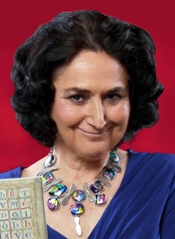Lorraine Kochanske Stock

Lorraine Kochanske Stock
English
Professor of Medieval literature and Medievalism
Office: 227B Roy G. Cullen
Phone: 713-743-2958
Email: lstock@uh.edu
I came to UH in 1976 as a specialist in Medieval Studies, focused on Middle English texts, Chaucer, and the Arthurian canon in England and Continental Europe. Although employing cinematic medievalism in pedagogy was always out there as an option, before the mid-1990s, I had never shown a film or even a clip of a scene from films about the medieval period in any course I taught, always rationalizing that it squandered precious in-class discussion/lecture time. In the late 90s, I underwent a scholarly and pedagogic sea change at the same time that UH revamped its core curriculum. I began in earnest to engage with Robin Hood Studies, a new scholarly direction for me, for which arguably more “texts” constitute feature films and TV series than printed literary works. Concurrently, UH reduced the former 6-credit hour requirement of 2000-level English/American literature courses to a mere 3 hours in any subject of the “Humanities.” To attract students to 2000-level English courses to satisfy this core requirement, I invented a new course, Engl 2315, Literature and Film, which was so well subscribed that I taught large sections of 90 students at a time. In the course, I covered films reflecting various texts about the Arthurian ethos, Robin Hood, and Beowulf. I had to learn the vocabulary and techniques of a new discourse, film analysis as well as the emerging field of Medievalism. I used select scenes from different film adaptations of the medieval literary works we covered to teach students how to analyze film scenes as “texts.” In learning how to write about this visual/aural medium, the students also became much more attentive to and skilled at writing about the verbal art of the literature they read.
Using film adaptations to teach about assigned literary texts proved so effective that thereafter I incorporated film analysis in all my undergraduate courses, even the undergraduate Chaucer course, which I transformed into a hybrid, using adaptations of Chaucer’s Canterbury Tales, film documentaries about the medieval period, and other visual materials to enhance students’ appreciation of what was for them a text written in the foreign language of Middle English. There was so much cinematic material about Robin Hood that I cut the outlaw’s unit from Engl 3302 Medieval Literature and gave the topic its own course, Engl 4376 Robin Hood in Culture. Offered annually, this course examines how this British mythic figure has been appropriated in all aspects of high and popular culture worldwide, from medieval ballads to 21st-century political discourse. By now, every course I teach, at the lower division, upper division, or graduate level, employs analysis of adaptations of the literary works in cinema and other media. My scholarship now includes numerous conference presentations and published essays about film adaptations of medieval literary works or medievalism. I use Linda Hutcheon’s A Theory of Adaptation as a theoretical framework for all my classes. The past four doctoral dissertations I directed have been about adaptations of major or minor medieval literary works into various media: literary adaptations of earlier texts into different genres; film/TV; radio dramas; or other media. Although I came late in my career to Film Studies, that discourse is now an essential part of my scholarly and pedagogic toolkit.
Critical Studies Courses
- ENGL 3302 - Medieval Literature
Explores “texts” in various media (especially film and TV) include Sir Gawain and the Green Knight, Beowulf, etc. Students write several papers comparing a scene from a film adaptation to the episode in the the original text. We use the first chapter of Linda Hutcheon’s A Theory of Adaptation as a theoretical framework.